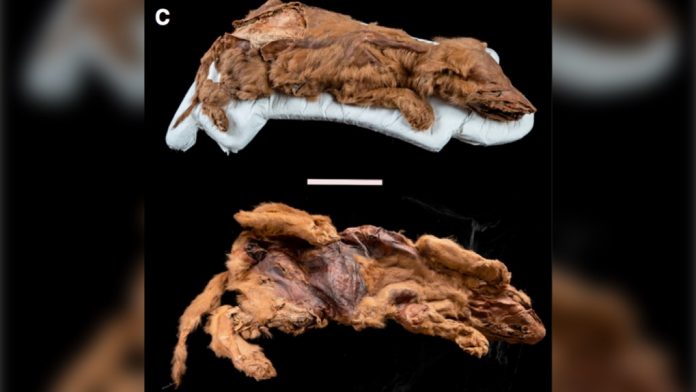A mummified wolf puppy has been found in Yukon Territory, where it was perfectly preserved in the permafrost for an estimated 57,000 years.
The puppy mummy is “100 per cent intact” and offers an unprecedented glimpse into the lives of ancient wolves, according to a new study published Monday in Cell Biology. The puppy was likely six to eight weeks old when its wolf den caved in on top of it, trapping it under the frozen earth and transforming it into a mummy over many millennia.
The animal was a grey wolf (Canis lupus) akin to those alive today, though it lived a different life from modern wolves, according to the study.
Scientists in the U.S. and Canada have named the mummy Zhur, which means “wolf” in the language of the local Tr’ondëk Hwëch’in people.
“Zhur is unique because mummified bodies with preserved hair, skin and flesh like this are incredibly rare from North America,” said Grant Zazula, a paleontologist with the government of Yukon.
Gold miners discovered the mummy while they were melting a wall of permafrost with water near Dawson City in 2016. The corpse was trapped in the frozen mud.
“She’s the most complete wolf mummy that’s ever been found,” lead study author Julie Meachen told EurekAlert.
Meachen is an anatomy professor at Des Moines University in Iowa and played a major role in determining the animal’s age.
“The fact that she’s so complete allowed us to do so many lines of inquiry on her to basically reconstruct her life,” she said.
Researchers spent four years studying the mummy in detail to determine its age, diet and cause of death.
They were surprised to learn that Zhur ate a lot of fish, when they’d expected oxen and bison to play a larger role in its diet. Zhur’s genes revealed that it was a descendant of the ancient wolves that once roamed Alaska and Siberia. However, the wolf is likely not a direct ancestor of grey wolves living in the region today.
Researchers also determined that the pup was likely alone in the den when it died, and that it was probably a quick death. The cold temperatures and soil would have been perfect for creating the mummy, they say.
It’s extremely rare to find a mummified wolf in the Yukon, but millennia-old mummies are becoming increasingly common in the once-frigid parts of the world due to climate change. In Siberia, for example, melting permafrost has revealed many woolly mammoths and other Ice Age corpses in recent years.
“One of the consequences of climate change in the Arctic is that more of these mummies will be found in the future,” Meachen said in a video released with the study.
“And while this is really interesting for science, it highlights one of the problems of global warming, and we need to take action now to save this planet and all of its treasures.”
Zhur is currently on permanent display at the Yukon’s Beringia Interpretive Centre in Whitehorse.





























